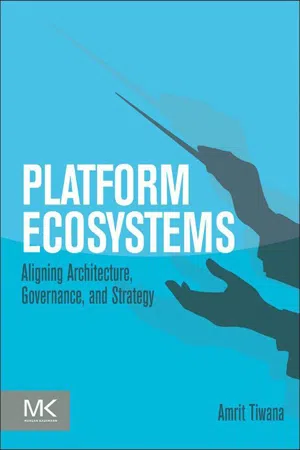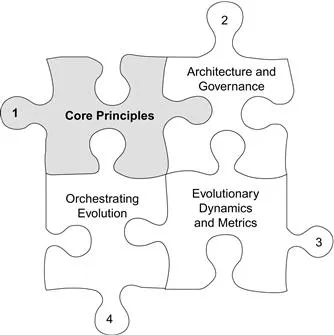![]()
Part I
The Rise of Platforms
Outline
Introduction
Chapter 1 The Rise of Platform Ecosystems
Chapter 2 Core Concepts and Principles
Chapter 3 Why Platform Businesses Are Unlike Product or Service Businesses
Chapter 4 The Value Proposition of Platforms
![]()
Introduction
![]()
Chapter 1
The Rise of Platform Ecosystems
Abstract
Platforms are creating an entirely new blueprint for competition, one that puts ecosystems in head-to-head competition. This chapter lays a foundation for introducing these ideas. It begins with an overview of software platforms and how they are changing the rules of competition. It then identifies the central elements of platform ecosystems and their competitive environment. It also clarifies what is not a platform. It then describes the five drivers of the migration toward software platforms in a variety of technology and nontechnology industries. These include the need for deepening specialization as firms struggle to deliver increasingly complex products and services, “packetization”; baking of routine business activities into software across a plethora of industries; the emergence of the Internet of Things; and the growing ubiquity of cheap, fast, and untethered digital networks. The confluence of these drivers can infuse properties of software platforms into products and services in mundane activities in non-technology industries, making platforms industry agnostic.
Keywords
platforms; ecosystems; modularity; packetization; confluence; dynamics; business ecosystems
May you live in interesting times.
Ancient Chinese curse
In This Chapter
• What platforms are and what they are not
• Core components of platform ecosystems
• Drivers of the migration toward platforms in diverse industries
1.1 The war of ecosystems
Blackberry had everything going right. It had fanatically loyal customers and its products were innovative, well engineered, durable, and got raving reviews from critics. After years of commanding a lion’s share (about 50%) of the smartphone market that it largely created, it had trouble breaking past a 1% market share with its newest products by 2012, leading to its subsequent downfall Blackberry assumed that the problem was Apple and then Google—both industry outsiders—who had since entered the fray. So, it did what made sense: Price more competitively, invest more in developing new products, upgrade its operating system, and step up marketing. Nothing worked. Its error was failing to realize that the basis for competition had changed: It was no longer Blackberry against Apple smartphones. Instead, it was the Blackberry ecosystem against the iOS ecosystem. It was not one product against another but Blackberry’s army of 8000 external innovators against Apple’s 200,000. Blackberry’s mistake was failing to realize the ecosystem on which its continued success depended. All three companies made good products, but the lack of enough innovative apps muted Blackberry’s market potential. It was already too late to catch up by the time Blackberry realized that the competitive blueprint had shifted. The Red Queen effect1—the need to run faster just to stay in the same place—had taken over.
Platforms are creating an entirely new blueprint for competition—one that puts ecosystems in head-to-head competition. The ongoing migration from product and service competition to platform-based competition in many industries and markets is driven by forces—packetization of products, services, and activities; software embedding and ubiquitous networking of everyday objects; and the increased need for specialization—that are increasingly infusing characteristics of the software industry into many nontechnology industries. What served firms well in product-based markets can become their Achilles heel in platform-based markets. Managing platform-based businesses requires an entirely different mindset for strategy. Most of the old rules of business are alive and well, but many of the assumptions behind them do not hold in such environments. However, few observers have moved beyond individual superstar anecdotes of Apple, Facebook, and Amazon to analyze the broader principles and mechanisms that generalize beyond them. How should platforms be designed? How should they be governed, controlled, and priced? How can the work of so many be coordinated in the absence of familiar organizational structures? How do these choices shape their evolvability, their competitive durability, and their survival? How can their design create win–win propositions for app developers and users? How does a product or service even become a platform? The objective of this book is to provide you with actionable tools to arrive at your own answers about platform design strategies, and for platforms beyond the idiosyncrasies of the few poster children of the popular press.
This book is based on two premises. First, that the migration of competition from products to platforms—in technology and nontechnology industries alike—requires a different mindset for managing them. Second, evolvability in unforeseeable ways is key to thriving in platform markets but is rarely the dominant emphasis in complex software systems. Architecture and strategy are the two gears of a platform’s evolutionary motor that must interlock and align. Evolution2 is therefore predicated in the interplay between its irreversible architecture and how it is governed. Platforms that thrive are ones whose ecosystems outpace rival ones in the evolutionary race. They orchestrate their ecosystems to leverage the drive and expertise of many outsiders without compromising ecosystem-wide integration. But not all platforms are created equal; the seeds of effective orchestration are sown in their early architecture. This is also where the landmines that lead to their collapse are hidden.
This chapter lays a foundation for introducing these ideas. It begins with an overview of software platforms and how they are changing the rules of competition. It then identifies the central elements of platform ecosystems and their competitive environment. It also clarifies what is not a platform. It then describes the five drivers of the migration toward software platforms in a variety of technology and nontechnology industries ranging from smartphones, appliances, fast food, craft machines, automobiles, medicine, and professional services. These include (1) the need for deepening specialization as firms struggle to deliver increasingly complex products and services; (2) the “packetization” of products, services, business processes, and activities; (3) the baking of routine business activities into software across a plethora of industries; (4) the emergence of the Internet of Things; and (5) the growing ubiquity of cheap, fast, and untethered digital networks. The confluence of these drivers can infuse properties of software platforms into products and services in mundane activities in nontechnology industries, making this book’s content surprisingly industry agnostic. This transformation can change how firms make money, retain customers, organize, and survive.
1.2 Platform ecosystems
Platform-based software ecosystems such as the iOS and its 800,000 “apps” produced by 200,000 firms or Facebook and its 9 million apps are increasingly becoming the dominant model for the software industry and digital services.3 The utility of almost any platform is increasingly shaped by the ecosystem that surrounds it. Take Apple’s record-breaking iOS platform that includes the iPhone, iPod, and iPad. Its value to its 365 million users comes largely from the 800,000 complementary apps over which Apple has little ownership. Unlike traditional software development, platforms are designed to leverage the expertise of a diverse developer community—with ingenuity, hunger, skills, and an appreciation of user needs that platform owners might not possess. The emergence of such platform ecosystems (simply, systems composed of diverse smaller systems) is relocating the locus of innovation from the firm to a massive network of outside firms. The goal is to rapidly develop new capabilities and foster innovations unforeseeable by the platform’s original designers. The idea of a platform as a foundation on which one builds is not new. Product families have existed in the tooling industry for decades, automotive platforms underpinned General Motors’ dominance over Ford in the 1920s, operating systems are the engines in the IT industry, and “two-sided markets” that bring together buyers and sellers have existed since medieval times (Eisenmann et al., 2006; Fichman, 2004; Katz and Shapiro, 1994). But software infuses unique but poorly understood properties into platforms.
Our focus in this book is on software-based platforms, which create distinctively more complex opportunities and challenges than other types of platforms. They also function on a scale that is unprecedented in the industrial age because they allow literally hundreds of thousands of small companies to collectively do things that a traditional network of partners or intricate supply chains could not even dream of accomplishing. The potential power of platform ecosystems comes from leveraging the unique expertise of many, diverse independent app developers driven by market incentives on a scale that is impossible to replicate within a single organization. The platform model essentially outsources to thousands of outside partners innovation that used to be done inhouse, who bear all the cost and risk of innovating and then share the proceeds with the platform owner. The platform model throws the brainpower of thousands of small firms, mixes it with their hunger to succeed in the market, and lets the market determine the winners and losers. This potent mix of specialized expertise with the disciplining power of markets can foster innovation at a rate that exceeds by orders of magnitude conventional business models. Products that became platforms from 1990 until 2004 enjoyed a 500% increase in innovation, most of which came from outside developers (Boudreau, 2010). A platform’s success therefore depends not only on the platform owner, but also on a multitude of ecosystem partners’ ability to deliver (Adner, 2012, p. 1).
1.2.1 Elements of a software platform ecosystem
A platform-based ecosystem consists of two major elements—a platform and complementary apps—as Figure 1.1 illustrates. A software platform is a software-based product or service that serves as a foundation on which outside parties can build complementary products or services. A software platform is therefore an extensible software-based system that provides the core functionality shared by “apps” that interoperate with it, and the interfaces through which they interoperate (Baldwin and Woodard, 2009; Tiwana et al., 2010). We refer to the lead firm primarily responsible for the platform as the platform owner, sometimes also called the ecosystem’s keystone firm (Iansiti and Levien, 2004) or the economic catalyst (Evans and Schmalensee, 2007). Platform ownership can be shared by multiple firms and a platform need not be proprietary or for-profit. An app refers to an add-on software subsystem or software service that connects to the platform to extend its functionality. Although such complementary subsystems are often also called add-ons, plug-ins, modules, and extensions, here we refer to such platform complements simply as apps and their developers as app developers. Apps are complementary goods for platforms; platforms are functionally more desirable when there are a wide variety of complements available to them. (Two products are complements when one increases the attractiveness of the other; think of...

